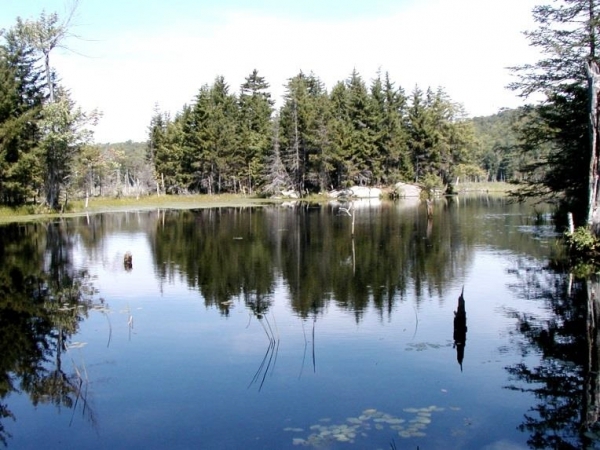ATHENS — The Turner Hill Wildlife Management Area has seen its share of human activity, most notably from Alec and Sally Turner, who farmed the land in the 19th century, and their daughter, Daisy, a storyteller and civil rights activist.
Now, the land that straddles the towns of Athens and Grafton is mostly devoid of human inhabitants, and beavers hold sway over the 1,052 acres.
The state now intends to manage the area to support plant and wildlife as well as limited recreational opportunities such as hiking trails.
On Thursday, April 18, a public meeting will discuss the site's future, as described in Turner Hill's first long-range management plan, produced by the Vermont Department of Fish and Wildlife and the Department of Forests, Parks, and Recreation.
At the meeting, agency staff will provide an overview of the area and the draft plan. Audience members can ask questions and provide feedback, all of which will be recorded by staff.
“At this point in time, [the management plan] outlines what we found and what we plan to do in the future,” said Aaron Hurst, state lands forester.
Hurst hopes that as people familiar with the land weigh in on the agency's plans; they will point out any plants, wildlife, or recreation opportunities the agency has missed.
The stewardship goals outlined for Turner Hill include management strategies that will support the plant and animal species found on the site.
Such strategies include improving deer wintering areas and ensuring production of “mast,” trees or shrubs like oak, cherry, raspberry, or beech which produce berries or nuts.
As management plans go, this one came together quickly, he said.
Building a forest, one parcel at a time
From 2011, when the management area was established, the Department of Forests, Parks, and Recreation purchased five parcels of land one at a time until 2015 to create what is now Turner Hill.
Extensive assessments of the plants, trees, and wildlife that populate the area followed. Staff completed the long-range management plan in March.
“For us, that's breakneck speed,” Hurst said.
Accessed from Grafton via the steep and graveled Turner Hill Road, or by Athens' Walker Road off Vermont Route 35, the management area is relatively new to the agency.
In 2018, the Windham Foundation purchased five acres that was the site of Journey's End, a farm owned by former slaves Alec and Sally Turner. The Turners' homestead is not part of the management area, explained Hurst.
The Windham Foundation will independently redevelop the area as a community eduction or recreational site, he said.
Bulrushes and beavers
Hurst said the agency wasn't looking to acquire new state lands in southeastern Vermont.
But an unassuming plant called the Northeastern bulrush changed that.
Protected under the Federal Endangered Species Act and the Vermont state endangered species statute, the plant thrives in here-today-gone-after-a-few-years kinds of wetlands.
Under the management plan, the department plans to conserve these beaver-influenced wetlands.
According to Hurst, beavers tend to inhabit an area as long as there is a food source. Once they've exhausted their food, they abandon their dam and move on. The dam eventually decays, and the pond and surrounding wetland eventually dries up.
Without the federally protected species and without partnering with the federal government, the agency probably wouldn't have established the Turner Hill Management Area, he said.
The wetlands are one of Turner Hill's defining characteristics, at least from a management perspective, said Hurst. Other interesting aspects include the spotted wintergreen, a plant that is rare in Vermont because the state sits at the northern edge of its habitat.
The area also contains deer wintering areas and signs of moose and bear, who are also partial to wetlands, added Hurst.
He called a population of lowland spruce within Turner Hill “an interesting feature” for this area of the state.
He also said snowshoe hares are drawn to the habitat created by the property's spruce trees.
A rare large tract of true woods
Hurst and the management plan outline a few of the area's features:
• Approximately 274 acres of a hemlock and hemlock-northern hardwood community.
• Approximately 65.5 acres of wetlands
• A blue heron rookery near the parcel's center that is also part of a beaver wetland
Three plants that are rare or uncommon in the state include pinxter flower, inflated bladderwort, and northern long sedge.
Hurst added that the department remains vigilant in screening the area for invasive species.
“They really can seriously hurt an ecosystem,” he said. “And they have big consequences to the forest ecology.”
So far, invasive insects have not gained a foothold in Turner Hill.
But staff have found a few invasive plants, such as Eurasian honeysuckle, Japanese barberry, multiflora rose, common buckthorn, and Japanese knotweed.
Although these plants have not reached a level where they've begun having an impact on the native plants, they could pose a long-term threat for Turner Hill's ecosystem.
Hurst pointed out that a block of more than 1,000 acres devoted to wildlife is rare in the southeastern part of the state, where most of the land has been divided into smaller lots.
This parcelization can have many negative consequences on the natural environment, according to Hurst. It inhibits the travel of wildlife, he said, but it also inhibits human benefits such as forestry.
Ten acres can be managed by a forester, he said, but it won't contain the variety of species that a larger parcel will have.
“Ten acres isn't woods,” Hurst said.
